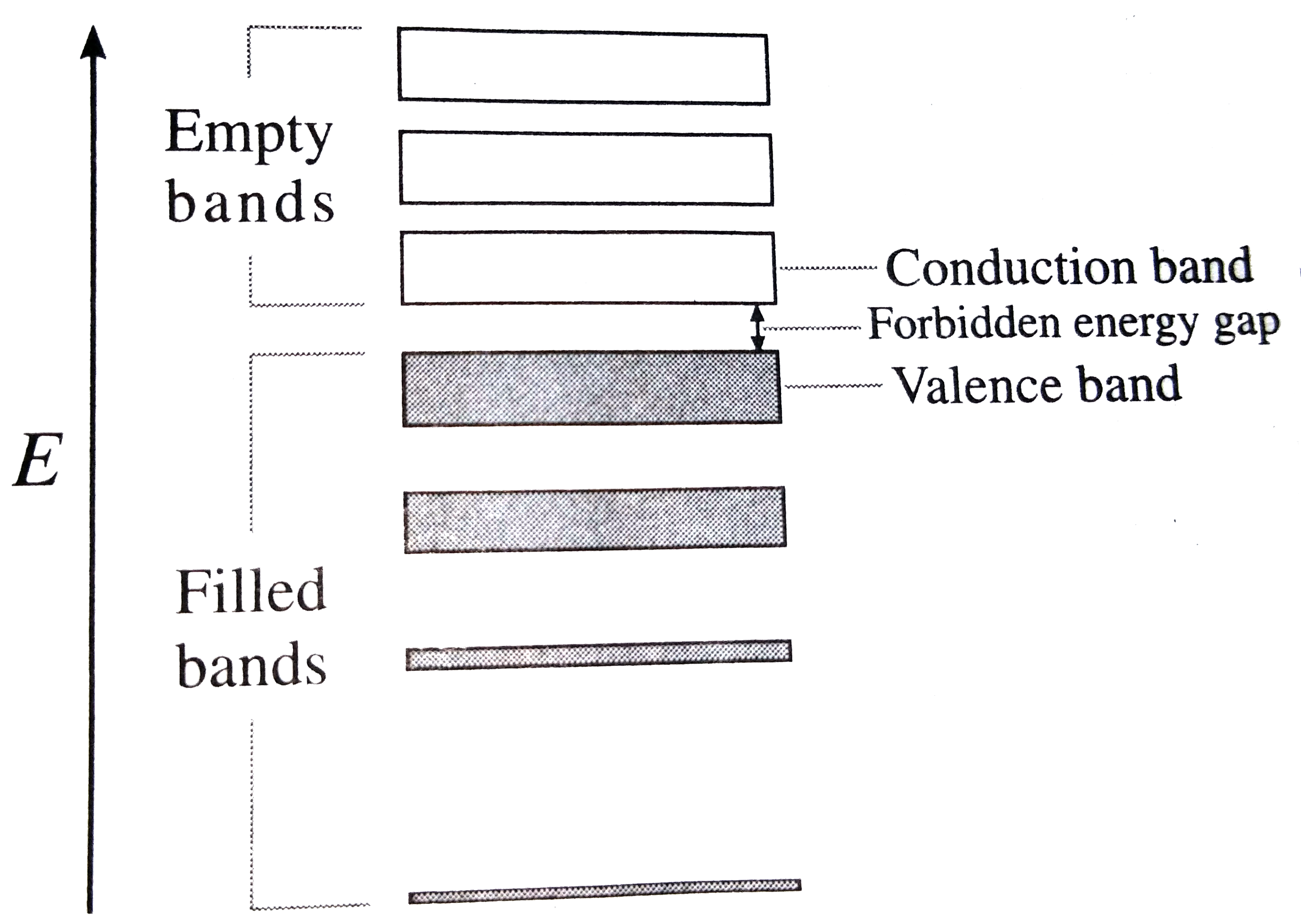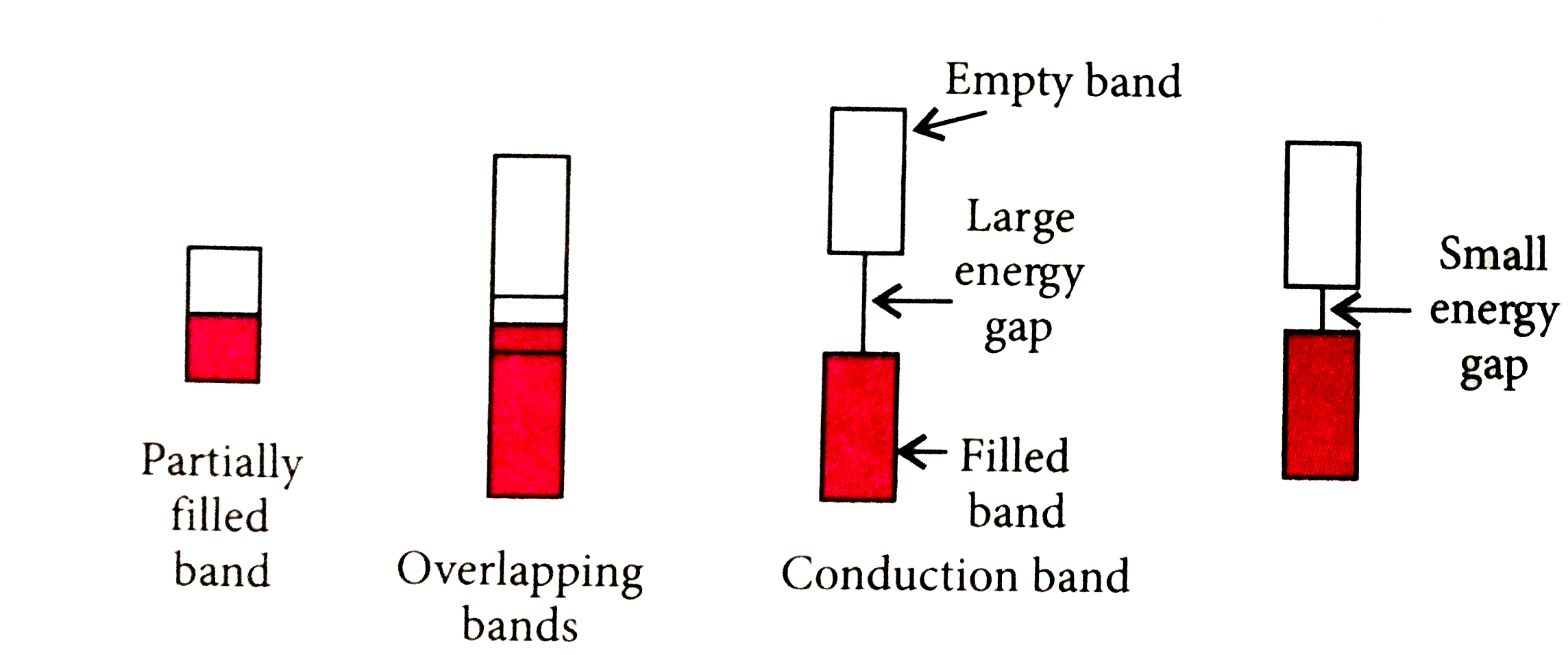Explain with a suitable diagram the concepts of valence band and conduction band.
A crystal consists of a three dimensional periodically repeating arrangement of a large number, say N, of the atoms, ions or molecules of the solid. An isolated atom is characterized by discrete and well-defined allowed electron energy levels. As the atomns come close together in a solid, for each of the discrete energy level of an atom, there are N such levels in the crystal. The energies of these N levels differ so slightly that their distribution is very nearly continuous and said to constitute an energy bands energies are formed which the electrons may occupy. These bands are separated by bands of forbidden energies.

The energy levels of inner shell electrons are not affected much by the presence of neighbouring atoms and hardly widen into bands. They play no part in determining the electrical properties of solids
The two energy bands which are important for electrical conduction a crystal are the highest almost-filled band and the lowest almost-empyt band, respectively called the valence and conduction bands. At or see absolute zero of temperature, the energy band whose all available states a occupied by valence electrons is called the valence band while the empyt electrical properties of solids. energy band above it is called the conduction band.
Topper's Solved these Questions
- BOOK - NAVNEET PUBLICATION - MAHARASHTRA BOARDCHAPTER - EXPLANATION, CHARACTERISTICS AND PROPERTIES EXERCISE - Communication Systems7videos
EXPLANATION, CHARACTERISTICS AND PROPERTIES
- BOOK - NAVNEET PUBLICATION - MAHARASHTRA BOARDCHAPTER - EXPLANATION, CHARACTERISTICS AND PROPERTIES EXERCISE - Assignments2videos
EXPLANATION, CHARACTERISTICS AND PROPERTIES
- BOOK - NAVNEET PUBLICATION - MAHARASHTRA BOARDCHAPTER - EXPLANATION, CHARACTERISTICS AND PROPERTIES EXERCISE - Atoms, Molecules and Nuclei6videos
EXPLANATION, CHARACTERISTICS AND PROPERTIES
- BOOK - NAVNEET PUBLICATION - MAHARASHTRA BOARDCHAPTER - EXPERIMENTS AND DIAGRAMSEXERCISE - ATOMS, MOLECULES AND NUCLEI1videos
EXPERIMENTS AND DIAGRAMS
- BOOK - NAVNEET PUBLICATION - MAHARASHTRA BOARDCHAPTER - INSTRUMENTS : CONSTRUCTION AND WORKING EXERCISE - Semiconductors6videos
INSTRUMENTS : CONSTRUCTION AND WORKING
Similar Questions
which of the following statements are true about metals ?
(a) Valence band overlaps with conduction band
(b)the gap between valence band and conduction band is negligible
(c) the gap[ between valence band and conduction band cannot be determined
(d) Valence band may remain partially filledView SolutionThree type of bands are shown in the figures given below showing the position of the valence band and conduction band. The figures A,B and C represent
 View Solution
View Solution
Knowledge Check
- Question 1 - Select One
In an insulator, the forbidden energy gap between the valence band and conduction band is of the order of
A1MeVB0.1MeVC1eVD5eV - Question 2 - Select One
In an insulator, the forbidden energy gap between the valence band and conduction band is of the order of
A1MeVB0.1MeVC1eVD5eV - Question 3 - Select One
The energy band gap between valence band and conduction band is maximum in
Ametals.Bsuper conductors.Csemiconductors.Dinsulators.
Three type of bands are shown in the figures given below showing the position of the valence band and conduction band. The figures A,B and C represent
 View Solution
View SolutionIn an insulator, the forbidden energy gap between the valence band and conduction band is of the order of
View SolutionIf there is a large energy gap between the filled valance band and empty conduction band, the subtance acts as……..
View SolutionThe fraction (f) of the number of electrons raised from valence band to conduction band at temperature TK in intrinsic semiconductor is given by........
View SolutionIf the energy gap between valence band and conduction band is 5 eV, then it is
View Solution

